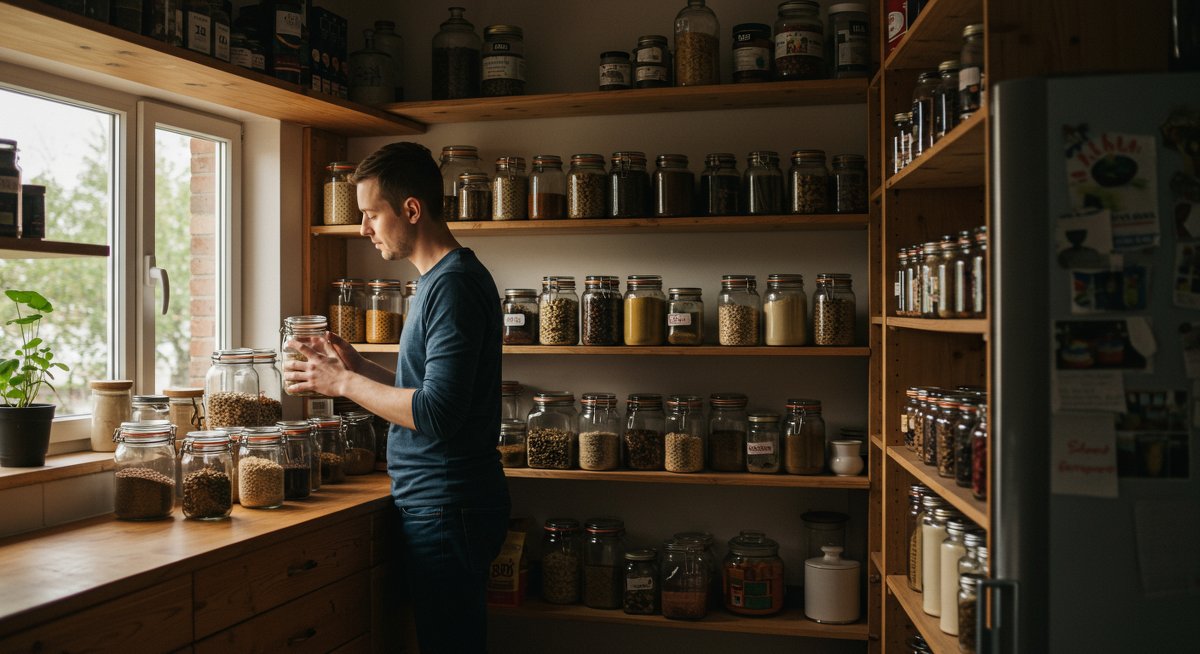
As experienced vegans, you likely have a solid grasp of plant-based cooking. However, taking your skills to the next level involves mastering a well-curated vegan pantry. This isn't just about stocking up on the basics; it's about understanding the versatility of each ingredient and how to use them to create exciting, flavorful, and convenient meals. This guide delves into essential pantry staples, offering expert insights, advanced strategies, and tips for optimizing your vegan cooking journey. We'll explore how to maximize flavor, minimize food waste, and create a truly efficient and inspiring vegan kitchen.
Deep Dive into Essential Vegan Pantry Staples
A well-stocked vegan pantry is the cornerstone of effortless and delicious plant-based cooking. Let's explore some essential ingredients, broken down into categories, with advanced tips for maximizing their potential:
Grains and Starches
Grains and starches form the foundation of many vegan meals, providing energy, fiber, and a variety of textures. Beyond the basics of rice and pasta, consider these advanced options:
- Quinoa: A complete protein, quinoa cooks quickly and adds a nutty flavor. Beyond salads, use it in breakfast bowls, veggie burgers, and as a rice substitute.
- Example: Try a quinoa and black bean salad with a lime vinaigrette, or quinoa-stuffed bell peppers for a satisfying meal.
- Expert Tip: Rinse quinoa thoroughly before cooking to remove the bitter saponins.
- Oats: Rolled oats are versatile. Use them for oatmeal, granola, or as a binding agent in veggie burgers. Consider steel-cut oats for a chewier texture.
- Example: Make overnight oats with plant-based milk, chia seeds, and berries for a quick and healthy breakfast.
- Expert Tip: Store oats in an airtight container to maintain freshness and prevent insect infestation.
- Pasta: Whole-wheat and lentil pasta offer more fiber and protein. Experiment with different shapes and sizes to elevate your meals.
- Example: Create a lentil pasta primavera with seasonal vegetables, or a hearty whole wheat pasta bake.
- Expert Tip: Cook pasta al dente to maintain its texture and prevent it from becoming mushy.
Legumes and Beans
Legumes and beans are protein and fiber powerhouses, crucial for a balanced vegan diet. Expand beyond canned beans with these options:
- Dried Beans: Buying dried beans is more economical and allows you to control sodium levels. Stock up on a variety like black beans, chickpeas, lentils, and cannellini beans.
- Example: Make your own hummus with dried chickpeas, or a hearty lentil soup.
- Expert Tip: Soak dried beans overnight (or use a quick soak method) to reduce cooking time and improve digestibility.
- Bean Flours: Chickpea flour (besan) and other bean flours add protein and a unique flavor to baked goods, pancakes, and savory dishes.
- Example: Use chickpea flour to make socca, a savory pancake, or as a binder in vegan meatballs.
- Expert Tip: Store bean flours in the refrigerator or freezer to prevent rancidity.
- Tofu and Tempeh: These soy-based staples are incredibly versatile. Explore different varieties of tofu (firm, extra-firm, silken) and tempeh for varied textures and flavors.
- Example: Marinate and bake extra-firm tofu for a crispy protein, or crumble tempeh and add it to pasta sauces.
- Expert Tip: Press tofu to remove excess water, ensuring a firmer texture and better flavor absorption.
Nuts and Seeds
Nuts and seeds offer healthy fats, protein, and essential nutrients. Incorporate these for added flavor and texture:
- Nuts: Almonds, cashews, walnuts, and pecans add crunch and richness. Use them in trail mixes, salads, or as a base for sauces and creams.
- Example: Make cashew cream for a decadent sauce, or sprinkle toasted almonds on a salad.
- Expert Tip: Store nuts in the freezer to prevent them from going rancid, especially in warm climates.
- Seeds: Chia seeds, flaxseeds, hemp seeds, and sunflower seeds boost nutrition. Add them to smoothies, yogurt, or baked goods.
- Example: Make chia seed pudding, or sprinkle flaxseeds on your oatmeal for added omega-3 fatty acids.
- Expert Tip: Grind flaxseeds just before use to maximize their nutritional benefits.
Condiments and Spices
These ingredients are the secret weapons for creating complex and flavorful vegan dishes. Invest in high-quality options:
- Nutritional Yeast: This inactive yeast adds a cheesy, savory flavor. Use it on popcorn, pasta, or in sauces.
- Example: Sprinkle nutritional yeast on roasted vegetables for a cheesy topping, or add it to a vegan mac and cheese sauce.
- Expert Tip: Store nutritional yeast in an airtight container to preserve its flavor.
- Spices: A well-stocked spice rack is essential. Start with basics like salt, pepper, garlic powder, onion powder, paprika, cumin, chili powder, and dried herbs. Then, expand your collection based on your favorite cuisines.
- Example: Experiment with different spice blends to create unique flavor profiles.
- Expert Tip: Store spices in a cool, dark place to maintain their potency.
- Vinegars: Balsamic, apple cider, and red wine vinegar add acidity and depth of flavor.
- Example: Use balsamic vinegar in a glaze, or apple cider vinegar in a salad dressing.
- Expert Tip: Use vinegars sparingly, as a little goes a long way.
Advanced Strategies and Insights
Beyond the basic ingredients, consider these advanced strategies for a truly exceptional vegan pantry:
- Batch Cooking and Meal Prep: Plan your meals and prepare components in advance (e.g., cooking grains, roasting vegetables). This saves time and makes healthy eating easier during the week.
- Example: Cook a large batch of quinoa on Sunday and use it throughout the week in salads, bowls, and side dishes.
- Expert Tip: Invest in good-quality containers for storing prepared meals and ingredients.
- Minimizing Food Waste: Plan your meals around what you have on hand to reduce food waste. Get creative with leftovers and use every part of the vegetable (e.g., vegetable broth from scraps).
- Example: Use leftover vegetable scraps to make a flavorful vegetable broth.
- Expert Tip: Store vegetables properly to extend their shelf life (e.g., store leafy greens in a container lined with a paper towel).
- Flavor Building Techniques: Experiment with different flavor combinations and techniques to elevate your dishes. Consider using umami-rich ingredients like mushrooms, sun-dried tomatoes, and miso paste.
- Example: Roast vegetables to concentrate their flavors, or sauté them with aromatics like garlic and onions.
- Expert Tip: Taste as you cook and adjust seasonings to your liking.
Optimizing Your Vegan Kitchen
Efficiency is key to a successful vegan lifestyle. Here's how to optimize your kitchen for seamless cooking:
- Organization: Organize your pantry by category (grains, beans, spices, etc.) to easily find what you need. Use clear containers to see contents at a glance.
- Example: Store spices in a drawer or spice rack for easy access.
- Expert Tip: Label all containers with the contents and expiration dates.
- Essential Tools: Invest in a few essential kitchen tools that will make cooking easier and more enjoyable.
- Example: A good quality Vitamix Blender is great for smoothies, soups, and sauces.
- Expert Tip: Prioritize quality over quantity when purchasing kitchen tools.
- Pantry Inventory: Regularly take inventory of your pantry to know what you have and what you need. This prevents duplicate purchases and ensures you always have the ingredients you need on hand.
- Example: Create a simple spreadsheet or use a pantry inventory app to track your ingredients.
- Expert Tip: Plan your meals before grocery shopping to avoid impulse buys.

Case Study: Thriving on an Advanced Vegan Path
Meet Sarah, a long-time vegan who transformed her pantry from a collection of basics to a culinary powerhouse. Sarah, a busy professional, struggled to find time to cook consistently. However, by investing in a well-stocked pantry and adopting advanced strategies, she streamlined her cooking process and significantly improved her diet.
- Problem: Sarah found herself resorting to takeout or quick, unhealthy meals due to time constraints. She lacked the variety and flavor she craved.
- Solution: Sarah revamped her pantry, adding a variety of grains, beans, nuts, seeds, and spices. She started batch cooking on weekends, preparing components like cooked grains and roasted vegetables. She also adopted flavor-building techniques, like making her own spice blends and experimenting with umami-rich ingredients.
- Results: Sarah now enjoys delicious, home-cooked vegan meals every day. She saves money by cooking at home and reduces food waste by planning her meals and using leftovers creatively. She feels more energized and has a greater appreciation for the art of vegan cooking.
Sarah's Advanced Pantry Essentials:
- Grains: Quinoa, brown rice, and steel-cut oats.
- Legumes: Dried lentils, chickpeas, and black beans.
- Nuts & Seeds: Almonds, cashews, chia seeds, and flaxseeds.
- Condiments: Nutritional yeast, miso paste, balsamic vinegar, and a variety of spices.
Integrating Advanced Vegan Practices
- Embrace International Cuisines: Expand your culinary horizons by exploring vegan dishes from different cultures. Each cuisine offers a unique combination of flavors and ingredients.
- Homemade vs. Store-Bought: While convenience is key, consider making your own sauces, dressings, and even plant-based milks. This allows you to control ingredients and reduce packaging waste.
- Seasonal Eating: Embrace seasonal produce to maximize flavor and reduce your environmental impact. Adjust your pantry staples based on the season.
- Experimentation and Creativity: Don't be afraid to try new recipes and adapt them to your liking. Vegan cooking is all about creativity and exploration.
Scaling Your Impact: Beyond Personal Choices
- Share Your Knowledge: Inspire others by sharing your knowledge and experience with vegan cooking. Host cooking classes, share recipes online, or simply talk to your friends and family.
- Support Vegan Businesses: Choose vegan-friendly restaurants, brands, and businesses to support the growth of the vegan movement.
- Advocate for Veganism: Advocate for veganism by supporting animal rights organizations and promoting ethical consumption.
Expert-Level Vegan Living Insights
- Flavor layering: Combining multiple flavor elements in a dish adds complexity and depth to your meals. This can involve using both fresh and dried herbs, various spices, and different cooking methods.
- Fermented foods: Include fermented foods like kimchi, sauerkraut, and tempeh, which are great for your gut health.
- Sustainable sourcing: Buy ingredients from local and sustainable sources as much as possible to minimize your environmental impact.
Your journey into advanced vegan cooking is an ongoing adventure. By continually expanding your knowledge, experimenting with new recipes, and refining your approach, you'll unlock a world of delicious possibilities while aligning with your values. Embrace the journey, and enjoy the process of creating a vibrant, ethical, and fulfilling life through the power of plant-based cuisine.